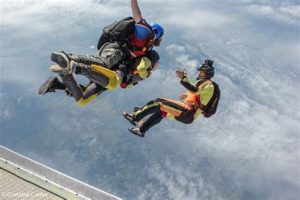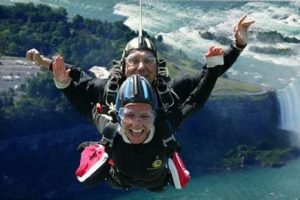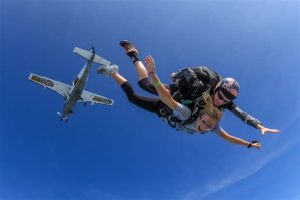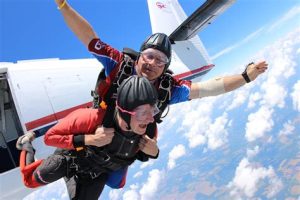Table of Contents
Curious about the risks of tandem skydiving? Discover how dangerous tandem skydiving can be with this insightful analysis. Explore the safety precautions, statistics, and expert advice to make an informed decision before taking the leap of a lifetime.
Tandem skydiving is an exhilarating and adrenaline-pumping adventure that draws thrill-seekers from all walks of life. However, it is essential to acknowledge the potential dangers associated with this extreme sport. With every jump, participants must consider the risks involved in entrusting their lives to a parachute and the expertise of their tandem instructor. In this article, we will explore just how perilous tandem skydiving can be and shed light on the precautions one must take before embarking on this daring expedition.
Introduction
Tandem skydiving is an exhilarating activity that allows individuals to experience the thrill of freefalling from thousands of feet above the ground. It involves jumping out of a plane while securely harnessed to an experienced instructor who controls the parachute descent. While many people are drawn to the adrenaline rush and sense of adventure, it’s important to understand the potential dangers associated with this extreme sport.
The Importance of Safety Measures
When engaging in any high-risk activity, safety precautions are of utmost importance. Tandem skydiving is no exception. Before taking part in a jump, participants must undergo thorough training to ensure they understand the proper procedures and safety protocols. This training covers everything from how to exit the aircraft to how to land safely.
Equipment Inspections
Prior to every jump, the equipment used in tandem skydiving must be meticulously inspected by certified professionals. This includes checking the integrity of the harnesses, the deployment system of the parachute, and the condition of the reserve chute. Any signs of wear or damage can result in grounding the equipment until repairs or replacements are made.
Weather Conditions
One of the most critical factors in ensuring a safe tandem skydiving experience is suitable weather conditions. Wind speed, cloud cover, and visibility all play a significant role. Experienced instructors closely monitor weather forecasts and make informed decisions to postpone or cancel jumps if conditions are deemed unsafe.
Parachute Malfunctions
Although rare, parachute malfunctions can occur during tandem skydiving. This is why each jump includes a reserve parachute as an added safety measure. Instructors are trained to handle such situations and can quickly deploy the reserve chute if necessary. Additionally, regular maintenance and inspections of the parachutes reduce the risk of malfunction.
Medical Considerations
While tandem skydiving is generally safe for individuals in good health, there are certain medical conditions that may pose risks. People with heart conditions, high blood pressure, or respiratory issues should consult with their doctor before participating. It’s crucial to provide accurate information about your health to the skydiving center to ensure your safety.
Adrenaline Rush and Emotional Preparedness
Tandem skydiving is an intense experience that can trigger a rush of adrenaline. While this can be thrilling, it’s essential to be emotionally prepared for such an extreme adventure. Individuals prone to panic or anxiety may find tandem skydiving overwhelming, and it’s important to evaluate one’s mental state before deciding to participate.
Landing Impact
The landing phase of a tandem skydive requires careful execution to minimize the risk of injuries. Instructors guide participants on how to properly position their bodies, so the impact is absorbed evenly across the legs and lower body. Following these instructions and maintaining a relaxed posture significantly reduces the chances of injuries upon landing.
Training and Experience of Instructors
The expertise and experience of the tandem skydiving instructor are crucial in ensuring a safe jump. Certified instructors undergo rigorous training and must meet specific qualifications and standards set by skydiving organizations. Their knowledge of equipment, emergency procedures, and proper techniques greatly reduces the inherent risks associated with the activity.
Statistical Safety Data
When considering the dangers of tandem skydiving, it’s important to examine statistical safety data. According to the United States Parachute Association, the rate of tandem skydiving fatalities is approximately 0.003% per jumps. While accidents can happen, the overall safety record of tandem skydiving remains relatively high.
Conclusion
Tandem skydiving carries inherent risks, as with any extreme sport. However, by adhering to strict safety measures, including thorough training, equipment inspections, and weather considerations, the risks can be minimized significantly. It’s crucial to choose a reputable skydiving center with experienced instructors who prioritize safety. With proper preparation and precautions, tandem skydiving can be an exhilarating adventure that is enjoyed safely by thousands of people worldwide.
How Dangerous Is Tandem Skydiving
Welcome to our guide on the safety considerations of tandem skydiving. In this article, we will explore the potential dangers associated with this adrenaline-filled activity. Whether you’re a first-time tandem jumper or conducting research, stay informed and learn about the risks involved.
Safety Statistics
To understand the dangers of tandem skydiving, let’s review safety statistics. According to reputable sources, such as the United States Parachute Association, only about one in every 1,000 tandem jumps results in a significant injury. While the numbers may appear low, it’s crucial to remember that accidents can happen in any extreme sport.
Weather Conditions
Weather plays a significant role in tandem skydiving safety. Understand that jumping during unfavorable weather conditions can be dangerous. High winds, low clouds, and storms may increase the risk of accidents and subsequently affect the safety of the jump. Always adhere to the advice of experienced instructors and be prepared for potential rescheduling due to weather concerns.
Instructor Competence and Training
One crucial aspect of tandem skydiving safety is the competence of the instructors. Ensure that the facility you choose employs experienced professionals who have undergone comprehensive training and hold the necessary certifications. Taking the time to research and verify the qualifications of your instructor will contribute to a safer skydiving experience.
Equipment Maintenance and Inspection
Another important consideration is the maintenance and inspection of the skydiving equipment. Understand that all equipment used in tandem skydiving must comply with safety regulations and be regularly inspected. Familiarize yourself with the facility’s maintenance practices and don’t hesitate to ask about the maintenance schedule and procedures followed.
Medical Precautions
Before participating in tandem skydiving, be aware of any medical conditions or limitations that may pose a risk. Some health issues, such as heart problems, asthma, or recent surgeries, may disqualify you from skydiving. It is crucial to consult with a medical professional and disclose any relevant information to the instructor to ensure your safety and well-being.
Emergency Procedures
Despite the precautions taken, emergencies can still occur during a tandem skydive. Understanding emergency procedures is essential for both instructors and jumpers. Familiarize yourself with instructions on how to handle situations such as parachute malfunctions or landing in unforeseen areas. Being prepared can help mitigate the risks associated with potential emergencies.
Personal Awareness and Responsibility
Tandem skydiving involves an element of personal responsibility. Acknowledging the dangers and risks associated with this extreme sport is crucial. Maintain an awareness of your surroundings, listen attentively to instructions, and follow all safety guidelines provided. By being responsible and focused throughout the experience, you can enhance your safety during tandem skydiving.
Participant Fitness and Training
Being physically fit is advantageous when engaging in any intense outdoor activity, and tandem skydiving is no exception. While previous training is not mandatory for tandem jumps, a certain level of fitness can contribute to a safer experience. Regular exercise, especially focusing on core strength and flexibility, can help minimize the risk of potential injuries during the jump.
Conclusion
Ultimately, tandem skydiving carries risks like any adventure sport. However, by choosing a reputable facility, ensuring proper instruction, and being aware of potential dangers, you can significantly minimize those risks. Remember, safety should always be a priority, but with the right precautions, tandem skydiving can be an exhilarating and memorable experience.
From my perspective, tandem skydiving can be an exhilarating yet potentially dangerous activity. It is important to understand the risks involved and follow proper instructions to ensure a safe experience.
Here are some points to consider regarding the dangers of tandem skydiving:
- Safety precautions are crucial: Skydiving centers have strict safety protocols in place to minimize risks. It is essential to listen carefully to the instructor’s instructions and follow them precisely. This includes wearing the appropriate gear, understanding the correct body position during the jump, and how to deploy the parachute correctly.
- Equipment failure: While rare, equipment malfunctions can occur during a tandem skydive. However, certified instructors are trained to handle such situations and carry backup parachutes to ensure a safe landing. Trusting the equipment and the expertise of your instructor is vital.
- Weather conditions: Weather plays a significant role in the safety of skydiving. Strong winds, storms, or low visibility can pose significant risks. Skydiving centers closely monitor weather conditions, and jumps may be postponed or canceled if conditions are deemed unsafe. Always adhere to the advice of professionals and be patient if your jump needs to be rescheduled.
- Medical considerations: Certain medical conditions or injuries may make tandem skydiving more dangerous. It is crucial to disclose any relevant information about your health to the instructor before your jump. They will assess whether it is safe for you to participate or recommend alternative options.
- Fear and anxiety: Tandem skydiving can be mentally challenging for some individuals due to fear or anxiety. It is essential to address these concerns with your instructor beforehand, as they can provide guidance and reassurance. They are experienced in dealing with nervous first-time jumpers and can help make the experience more comfortable.
While tandem skydiving does come with inherent risks, following instructions and taking necessary precautions can greatly minimize the danger involved. It is crucial to choose a reputable skydiving center with certified instructors and a strong safety record to ensure the highest level of safety during your jump.
Thank you for taking the time to read this article about tandem skydiving and exploring the question of its dangers. We hope that we were able to provide you with valuable insights and information regarding this thrilling adventure sport. Before we conclude, we would like to summarize the key points discussed throughout the article.
Firstly, it is important to acknowledge that tandem skydiving, like any extreme sport, carries inherent risks. However, it is crucial to understand that skydiving centers prioritize safety above all else. Qualified instructors undergo rigorous training and adhere to strict protocols to ensure the well-being of their tandem passengers. The equipment used is also regularly inspected and maintained to guarantee optimal performance. While accidents can never be completely eliminated, the chances of encountering a life-threatening situation during tandem skydiving are statistically very low.
Secondly, it is essential for potential tandem skydivers to be aware of the importance of following instructions provided by their instructor. Proper body positioning during the jump, maintaining a stable freefall, and executing a safe landing are all crucial aspects that can significantly reduce the risk of injury. By actively listening and cooperating with your instructor, you enhance your overall safety and enjoyment during the experience.
In conclusion, while tandem skydiving does involve risks, it is generally considered a safe activity when conducted under the supervision of trained professionals. By choosing a reputable skydiving center with experienced instructors, you can mitigate the potential dangers associated with the sport. Remember to always follow your instructor’s instructions and trust in their expertise. Tandem skydiving offers an unparalleled thrill and a unique perspective on the world, allowing you to conquer your fears and create unforgettable memories. So, if you’ve been contemplating taking that leap of faith, go ahead and embrace the adventure of tandem skydiving!
Video How Dangerous Is Tandem Skydiving
How Dangerous Is Tandem Skydiving?
1. Is tandem skydiving safe for beginners?
Tandem skydiving is considered relatively safe for beginners. As long as you follow the instructions provided by your instructor and adhere to safety protocols, the risk of any major accidents is minimized. Skydiving centers prioritize safety and employ highly trained professionals to ensure a secure experience.
2. What are the risks involved in tandem skydiving?
Like any adventure sport, there are inherent risks associated with tandem skydiving. These risks include parachute malfunctions, injuries during landing, or adverse weather conditions. However, these risks can be greatly mitigated by choosing a reputable skydiving center, following instructions carefully, and using proper safety equipment.
3. How often do accidents occur during tandem skydiving?
Accidents during tandem skydiving are relatively rare. According to statistics, the rate of serious injuries or fatalities in tandem skydiving is extremely low. Skydiving centers prioritize safety and conduct regular inspections of equipment to minimize the chances of accidents.
4. Can health conditions affect the safety of tandem skydiving?
Certain health conditions may impact the safety of tandem skydiving. It is important to inform your instructor about any pre-existing medical conditions or concerns before the jump. They will assess whether it is safe for you to participate and provide appropriate guidance to ensure your well-being throughout the experience.
5. What precautions can I take to make tandem skydiving safer?
To enhance the safety of your tandem skydiving experience, it is crucial to choose a reputable skydiving center with experienced instructors. Additionally, carefully follow all instructions provided by your instructor, wear appropriate safety gear, and maintain a positive attitude. Being mindful of weather conditions and rescheduling if necessary can also contribute to a safer skydiving experience.
Remember, tandem skydiving can be an exhilarating adventure, but it is essential to prioritize safety and follow all instructions given by your instructor. By doing so, you can minimize risks and enjoy the thrilling experience of skydiving with confidence.






